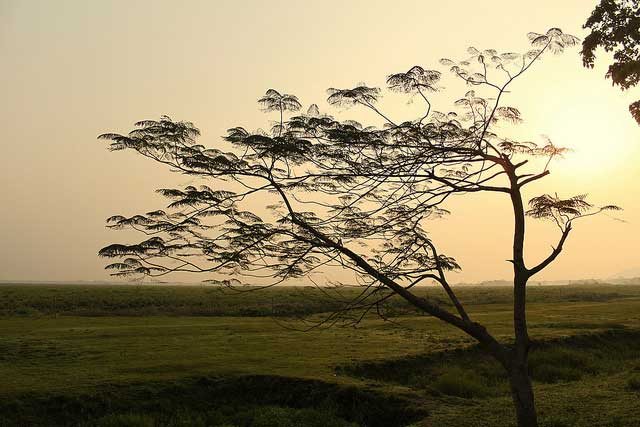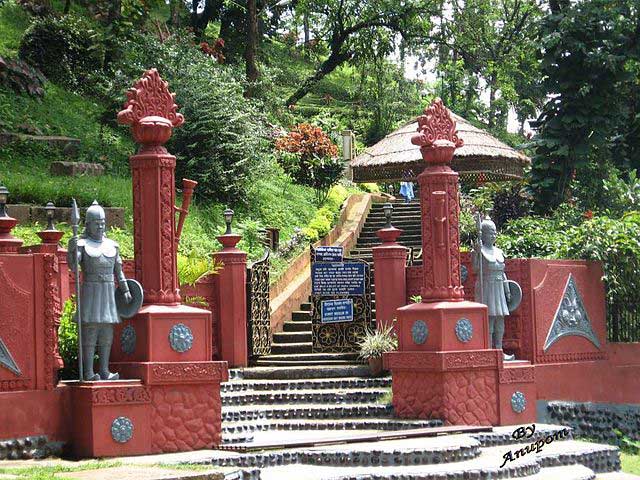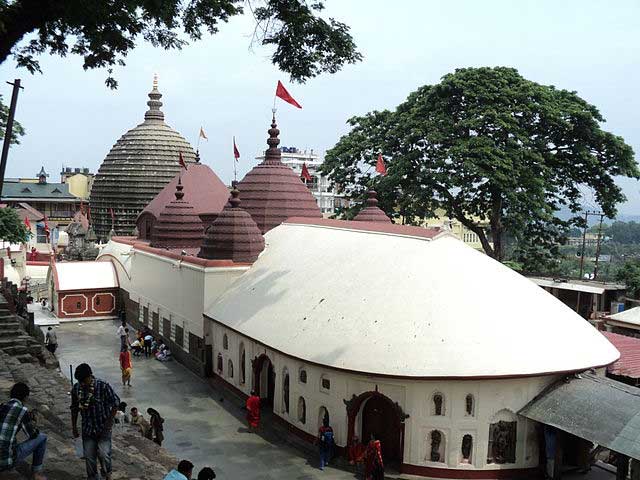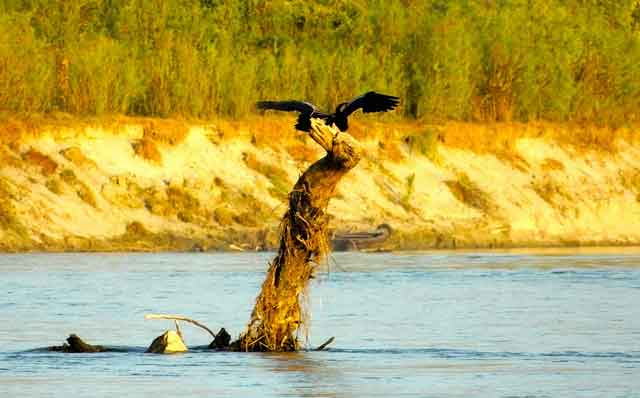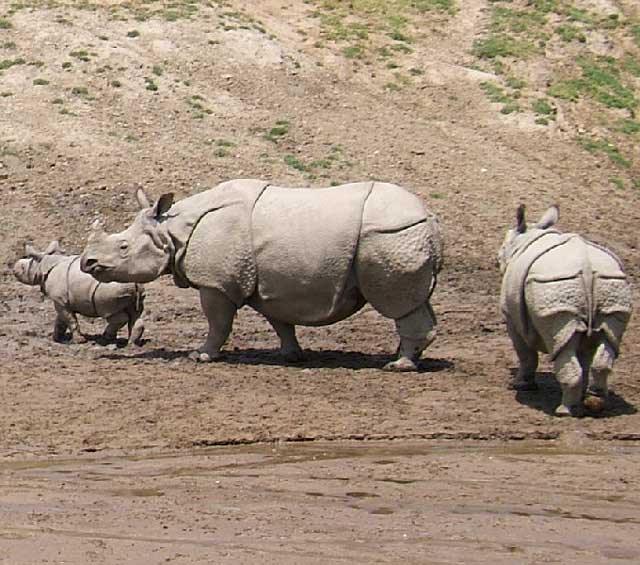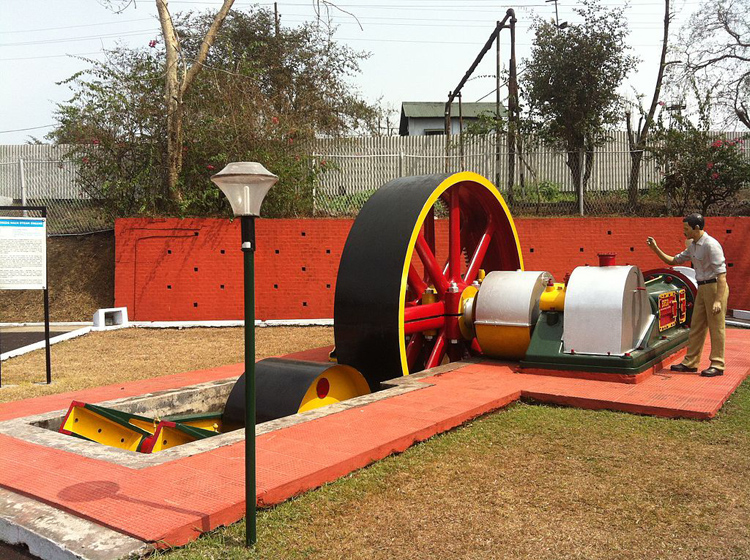The
Kamakhya Temple (
Assamese:
কামাখ্যা মন্দিৰ); also Kamrup-Kamakhya
[2] is a
Hindu temple dedicated to the
mother goddess Kamakhya.
[3] It is one of the oldest of the 51
Shakti Pithas.
[4] Situated on the Nilachal Hill in western part of
Guwahati city in
Assam,
India, it is the main temple in a complex of individual temples dedicated to the ten
Mahavidyas:
Kali,
Tara,
Sodashi,
Bhuvaneshwari,
Bhairavi,
Chhinnamasta,
Dhumavati,
Bagalamukhi,
Matangi and
Kamala.
[5] Among these, Tripurasundari, Matangi and Kamala reside inside the main temple whereas the other seven reside in individual temples.
[6] It is an important pilgrimage destination for general Hindu and especially for
Tantric worshipers.
In July 2015, the
Supreme Court of India transferred the administration of the Temple from the Kamakhya Debutter Board to the Bordewri Samaj.
[7]
Description]
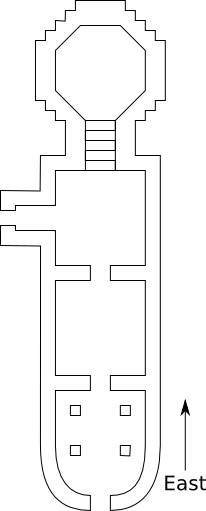
The plan of the Kamakhya temple. The four chambers from the top are:
garbhagriha,
calanta,
pancharatna and the
nritya-mandapa.
The current structural temple, built and renovated many times in the period 8th-17th century, gave rise to a hybrid indigenous style that is sometimes called the
Nilachal type: a temple with a hemispherical dome on a cruciform base.
[8]The temple consists of four chambers:
garbhagriha and three
mandapas locally called
calanta,
pancharatna and
natamandira aligned from east to west.
Garbhagriha
The
garbhagriha has a
pancharatha plan
[9] that rests on plinth moldings that are similar to the Surya Temple at Tezpur. On top of the plinths are dados from a later period which are of the Khajuraho or the Central Indian type, consisting of sunken panels alternating with pilasters.
[10] The panels have delightful sculptured
Ganesha and other
Hindu gods and goddesses.
[11] Though the lower portion is of stone, the
shikhara in the shape of a polygonal
beehive-like dome is made of brick, which is characteristic of temples in
Kamrup.
[12] The shikhara is circled by a number of minaret inspired
angashikharas[13]of Bengal type
charchala. The Shikhara, angashikharas and other chambers were built in the 16th century and after.
The inner sanctum, the
garbhagriha, is below ground level and consists of no image but a rock fissure in the shape of a
yoni:
The
garbhagriha is small, dark and reached by narrow steep stone steps. Inside the cave there is a sheet of stone that slopes downwards from both sides meeting in a
yoni-like depression some 10 inches deep. This hollow is constantly filled with water from an underground perennial spring. It is the vulva-shaped depression that is worshiped as the goddess Kamakhya herself and considered as most important
pitha (abode) of the Devi.
[14]
The garbhaghrihas of the other temples in the Kamakhya complex follow the same structure—a yoni-shaped stone, filled with water and below ground level.

The
adhisthana of the Kamakhya temple indicates that the original temple was of Nagara style

The
shikhara is of type common to medieval Assam, ringed by a cluster of
angashikhara of Bengal
charchala. Part of the
antarala is also visible, which is of type
atchala.
Calanta, Pancharatna, and Natamandir
The temple consists of three additional chambers. The first to the west is the
calanta, a square chamber of type
atchala (similar to the 1659 Radha-Vinod Temple of Bishnupur
[15]). The entrance to the temple is generally via its northern door, that is of Ahom type
dochala. It houses a small movable idol of the Goddess, a later addition, which explains the name.
[16] The walls of this chamber contain sculpted images of Naranarayana, related inscriptions and other gods.
[17] It leads into the
garbhagriha via descending steps.
The pancharatna to the west of calanta is large and rectangular with a flat roof and five smaller shikharas of the same style as the main skhikara. The middle shikhara is slightly bigger than the other four.
The
natamandira extends to the west of the
pancharatna with an apsidal end and ridged roof of the
Ranghar type Ahom style. Its inside walls bear inscriptions from Rajeswar Singha (1759) and Gaurinath Singha (1782), which indicate the period this structure was built.
[18]
History
Ancient
The earliest historical dynasty of
Kamarupa, the
Varmans (350-650), as well as
Xuanzang, a 7th-century Chinese traveler ignore the Kamakhya; and it is assumed that the worship at least till that period was
Kirata-based beyond the brahminical ambit.
[19] The first
epigraphic notice of Kamakhya is found in the 9th-century Tezpur plates of Vanamalavarmadeva of the
Mlechchha dynasty.
[20] Since the archaeological evidence too points to a massive 8th-9th century temple,
[21] it can be safely assumed that the earliest temple was constructed during the Mlechchha dynasty.
The later
Palas of Kamarupa kings, from
Indra Pala to
Dharma Pala, were followers of the
Tantrik tenet and about that period Kamakhya had become an important seat of Tantrikism. The
Kalika Purana (10th century) was composed and Kamakhya soon became a renowned centre of Tantrik sacrifices, mysticism and sorcery. Mystic Buddhism, known as Vajrayana and popularly called the "Sahajia cult", too rose in prominence Kamarupa in the tenth century. It is found from Tibetan records that some of the eminent Buddhist professors in Tibet, of the tenth and the eleventh centuries, hailed from Kamarupa. The
Kalika Purana gives the Sanskritized names of most of the rivers and hills of
Brahmaputra valley. It gives a full account of the
Naraka legend, the physical description of the land and the old city of
Pragjyotishpura as well as the special merit and sanctity of the Kamakhya Temple.
[22]
Medieval
There is a tradition that the temple was destroyed by
Kalapahar, a general of
Sulaiman Karrani (1566–1572). Since the date of reconstruction (1565) precedes the possible date of destruction, and since Kalapahar is not known to have ventured so far to the east, it is now believed that the temple was destroyed not by Kalapahar but during
Hussein Shah's invasion of the
Kamata kingdom (1498).
[23] The ruins of the temple was said to have been discovered by
Vishwasingha (1515–1540), the founder of the
Koch dynasty, who revived worship at the site; but it was during the reign of his son,
Naranarayan (1540–1587), that the temple reconstruction was completed in 1565. The reconstruction used material from the original temples that was lying scattered about, some of which still exists today. Banerji (1925) records that this structure was further built over by the rulers of the
Ahom kingdom.
According to historical records and epigraphic evidence, the main temple was rebuilt by Chilarai using the available stone ruins,
[24] with the brick dome being an innovation. The current final structure has been rebuilt during the
Ahom times,
[25] with remnants of the earlier
Koch temple carefully preserved.
[26][27][28]
According to a legend the
Koch Bihar royal family was banned by
Devi herself from offering puja at the temple. In fear of this curse, to this day no descendants of that family dares to even look upward towards the Kamakhya hill while passing by. Without the support of the Koch royal family the temple faced lot of hardship. By the end of 1658, the
Ahoms under king Jayadhvaj Singha had conquered the Kamrup and their interests in the temple grew. In the decades that followed the Ahom kings, all who were either devout
Shaivite or
Shakta continued to support the temple by rebuilding and renovating it.
[29]
Rudra Singha (reign 1696 to 1714) was a devout Hindu and as he grew older he decided to formally embrace the religion and become an orthodox Hindu by being initiated or taking sharan of a Guru, who would teach him the mantras and become his spiritual guide. But, he could not bear the thought of humbling himself in front of a Brahmin who is his subject. He therefore sent envoys to
Bengal and summoned Krishnaram Bhattacharyya, a famous mahant of
Shakta sect who lived in Malipota, near Santipur in
Nadia district. The mahant was unwilling to come, but consented on being promised to be given the care of the Kamakhya temple to him. Though the king did not take sharan
[clarification needed], he satisfied the mahant by ordering his sons and the Brahmins in his entourage to accept him as their spiritual guru.
When Rudra Singha died, his eldest son
Siba Singha (reign 1714 to 1744), who became the king, gave the management of the Kamakhya temple and along with it large areas of land (Debottar land) to Mahant Krishnaram Bhattacharyya. The Mahant and his successors came to be known as Parbatiya Gosains, as they resided on top of the Nilachal hill. Many Kamakhya priests and modern Saktas of Assam are either disciples or descendants of the Parbatiya Gosains, or of the Nati and Na Gosains.
[30]
Worship
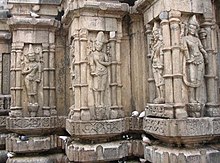
Sculptures carved on the temple
It is likely that this is an ancient
Khasi sacrificial site, and worshiping here still includes sacrifices. Devotees come every morning with goats to offer to
Shakti.
[31]
The worship of all female deity in Assam symbolizes the "fusion of faiths and practices" of Aryan and non-Aryan elements in Assam.
[32] The different names associated with the goddess are names of local Aryan and non-Aryan goddesses.
[33] The
Yogini Tantra mentions that the religion of the
Yogini Pitha is of
Kirata origin.
[34] According to Banikanta Kakati, there existed a tradition among the priests established by Naranarayana that the
Garos, a
matrilineal people, offered worship at the earlier Kamakhya site by sacrificing pigs.
[35]
The goddess is worshiped according to both the
Vamachara (
Left-Hand Path) as well as the
Dakshinachara (
Right-Hand Path) modes of worship.
[36] Offerings to the goddess are usually flowers, but might include animal sacrifices. In general female animals are exempt from sacrifice, a rule that is relaxed during mass sacrifices.
[37]
Legends

A complete view of the temple
Vatsyayana,a Vedic Sage in Varanasi during the later first Century was approached by the King in the Himalayan region (now Nepal) to find a solution to convert the tribals and their rituals of human sacrifice to a more socially accepted worship. The Sage suggested the worship of a tantric goddess Tara that spread towards the eastern Himalayan belt till the Garo Hills where the tribals worshipped a fertility '
yoni' goddess 'Kameke'. It was much later in the later Brahaminical period
Kalika Purana that most tantric goddess were related to the legend of 'Shakti' and began to be erroneously worshipped as a 'devi' by the Hindus.
According to the
Kalika Purana, Kamakhya Temple denotes the spot where
Sati used to retire in secret to satisfy her amour with
Shiva, and it was also the place where her
yoni fell after Shiva danced with the corpse of Sati.
[38] This is not corroborated in the
Devi Bhagavata, which lists 108 places associated with Sati's body, though Kamakhya finds a mention in a supplementary list.
[39]The
Yogini Tantra, a latter work, ignores the origin of Kamakhya given in
Kalika Purana and associates Kamakhya with the goddess
Kali and emphasizes the creative symbolism of the
yoni.
[40]
Festivals]

Local musicians singing bhajan at Kamakhya temple, Guwahati, Assam
Being the centre for Tantra worship this temple attracts thousands of tantra devotees in an annual festival known as the
Ambubachi Mela. Another annual celebration is the
Manasha Puja.
Durga Puja is also celebrated annually at Kamakhya during
Navaratri in the autumn. This five-day festival attracts several thousand visitors.
[41]
